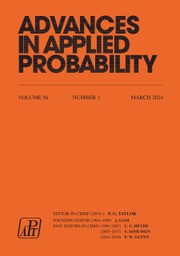Article contents
Sample path behaviour of Χ 2 surfaces at extrema
Published online by Cambridge University Press: 01 July 2016
Abstract
We study the sample path properties of χ2 random surfaces, in particular in the neighbourhood of their extrema. We show that, as is the case for their Gaussian counterparts, χ2 surfaces at high levels follow the form of certain deterministic paraboloids, but that, unlike their Gaussian counterparts, at low levels their form is much more random. This has a number of interesting implications in the modelling of rough surfaces and the study of the ‘robustness' of Gaussian field models. The general approach of the paper is the study of extrema via the ‘Slepian model process', which, for χ2 fields, is tractable only at asymptotically high or low levels.
Information
- Type
- Research Article
- Information
- Copyright
- Copyright © Applied Probability Trust 1988
Footnotes
Research supported in part by AFOSR Grants 84–0104 and 85–0384.
References
- 9
- Cited by

